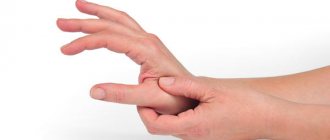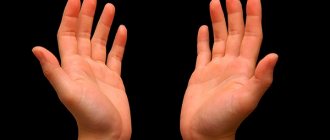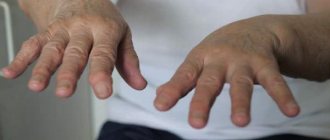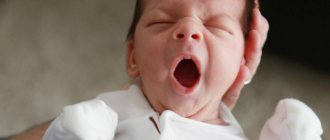Tremor in a newborn is a disorder that occurs from the first days in infants. It manifests itself in the form of systematic oscillatory muscle contractions. Shaking of the limbs and trembling of the chin are more common; head tremor occurs less frequently, which can signal severe pathologies of a neurological nature. During the three-month period from the moment of birth, tremor in a newborn child does not require therapeutic or corrective action. Increased muscle tone accompanying trembling indicates insufficient formation of nerve structures.
Tremor in a newborn is a fairly common phenomenon. As a rule, uncontrolled muscle contraction occurs more often due to strong arousal or during babies' dreams (REM sleep phase).
Causes of tremor in a newborn
Often the main reason that causes chin trembling and limb tremor in newborns is dysfunction of the endocrine glands and incorrect functioning of the nervous system. Such disorders often arise due to pathologies of intrauterine fetal formation.
Also, the causes of tremor in a newborn can be immaturity of the nervous system, oxygen starvation of the fetus during the process of intrauterine formation, and premature birth.
In the first weeks of the baby's birth, he may lack coordination of movements due to the immaturity of the nervous system, which will cause tremors in the newborn. Increased muscle tone is also a risk factor for tremor in a newborn. In addition, during emotional manifestations, babies may experience high levels of norepinephrine in their blood. Fetal hypoxia occurs due to disturbances in placental blood flow during pregnancy or during the birth process. It can also be triggered by intrauterine infection, dysfunction of the placenta, hemorrhage, increased uterine tone, and polyhydramnios. Oxygen deprivation can negatively affect the functioning of the brain.
Impairment of the baby's nervous system can be caused by entanglement of the fetus with the umbilical cord, weak labor or, conversely, rapid labor or placental abruption. These disorders impede the passage of oxygen to the brain, which can subsequently lead to chin tremor and shaking of the limbs in newborns.
Lip tremor in newborns is most often caused by premature birth. This is also due to the underdevelopment of the nervous system. The nervous system completes its formation outside the mother's womb, and even proper care cannot replace natural conditions. This is why premature babies are more likely to experience tremors than others.
In addition, scientists have previously proven that during pregnancy, the psychological state of the mother can also affect the subsequent occurrence of tremor in the newborn. Therefore, it is very important that a pregnant woman’s loved ones provide her with support, care, and prevent possible stress.
At what age does the appearance of tremor become a sign of illness?
In the development of a baby in the first year of life, these are the so-called critical periods of the formation of the nervous system. At this time, it is most vulnerable to disruptions in its functioning. These periods include the first and third, as well as the ninth and twelfth months of the baby’s life.
By the way, it is at this time that you should visit a pediatric neurologist. If tremors of the limbs or chin are observed longer than the specified age, then this can act as a sign of damage to the nervous system both during pregnancy and childbirth.
Chin tremor in a newborn
Tremor of the lips in newborns or trembling of the chin when crying or screaming in babies under three months of age is considered normal.
The causes of this condition in infants can often be due to insufficient development of their nervous and endocrine systems. At this age stage, the neurons responsible for movement are underdeveloped. In addition, the adrenal glands that produce the hormone norepinephrine are also immature in newborns. Both described factors, when combined, lead to tremor in a newborn.
Below are the main causes of chin tremor in a newborn.
Most often in infants, chin tremor is observed due to excessive physical stress or due to emotional overload, which indicates overexcitation of the nervous system. However, if chin tremor is observed in newborns in the absence of physical strain or crying, then this should definitely attract the attention of adults. Involuntary oscillatory muscle contractions may be a sign of increased muscle tone.
In most cases, a systematic relaxing massage is recommended to get rid of involuntary contractions of the chin muscles. In addition, regular warm baths with decoctions of valerian, mint or lemon balm are recommended. These plants have a relaxing and calming effect. However, you should not overuse them, as allergic rashes may appear. It will be enough to carry out balneological procedures at least three times every ten days.
If the symptoms of tremor in a newborn have not disappeared after three months, then it is necessary to consult a pediatric neurologist. Continuous trembling is often a sign of serious pathologies of the nervous system.
Balneotherapy, relaxing massage, early swimming - all of these activities help strengthen the children's nervous system, thereby eliminating the phenomenon of chin tremor.
What parents need to know at the preparatory stage
You have mastered the techniques of massaging your baby under the patronage of a specialist and can perform manipulations at home, in a familiar environment for your baby. Prepare for the massage:
- The room should have a comfortable temperature for a naked body. Before the massage, ventilate the room and dim the bright lights.
- For manipulation, choose a flat surface on which the baby will lie. It is more convenient to use the changing table.
- Choose a time for massage when the child is in a good mood. Usually - before water procedures, 1 hour before feeding. If the baby is capricious during the session, stop manipulation.
- Prepare your hands: cut your nails short, file the edges, and make sure there are no hangnails. Lubricate your brushes with nourishing cream and warm your fingers.
- Strengthen tactile sensations with a gentle voice. For example, say a tactile little rhyme: “Rails, rails, sleepers, sleepers, the train was late…”
For a massage to be effective, you need to master the basic movements: stroking, vibration, kneading and rubbing. Begin and end the procedure with gentle strokes. The session should take 5-10 minutes so that the baby does not freeze and the massage is enjoyable.
The result of a home massage greatly depends on environmental conditions and proper preparation of parents.
First of all, mothers should learn that they cannot take any active actions without the permission of a doctor. Inept massage can only worsen the child’s condition.
First, listen to your doctor. If he recommends any medications, do not resist. They are prescribed in difficult cases and are designed to improve the supply of oxygen to cells. Such drugs include Mydocalm, Pantogam, Glycine, etc.
In addition, if twitching of the head and limbs is a symptom of a disease of the nervous or endocrine systems, then the cause should be treated, not the effect. In this case, you cannot do without medications.
But most often, tremors can be dealt with using easier methods. These include: relaxing baths with herbs, therapeutic massage and, most importantly, creating a calm atmosphere around the child.
It is necessary to rid the child of all stressful situations as much as possible. Of course, there is no escape from feeding, bathing, dressing, but removing extraneous noise, providing the baby with pleasant, non-harmful lighting and a friendly atmosphere is something all parents can do.
Leg tremors in a newborn
Often in infants you can notice a slight trembling of the chin and twitching of the limbs. Such oscillatory muscle contractions in newborns are observed in almost fifty percent of cases during the first month of life. They occur when babies cry excessively, are frightened, or during the REM sleep phase due to excessive emotional arousal. The nervous system of infants is characterized by immaturity, which leads to excessive excitability, giving rise to some uncontrolled movements.
Leg tremors in a newborn may appear due to an increase in the level of norepinephrine in the blood, the excess of which gives rise to the same excessive emotional manifestations, again due to the immaturity of the adrenal medulla that produces this hormone.
In addition, there are critical stages in the formation of the nervous system of infants, during which the nervous structures are most vulnerable to the occurrence of disturbances or failures in its normal maturation. Such dangerous periods include the first month of a baby’s life, the third, ninth, and twelfth. It is at these stages that it is advisable to visit a pediatric neurologist.
If attacks of tremor in a newborn are observed after the baby is one year old, this may mean that either damage to the nervous structures is present at the moment, or it occurred at the stage of intrauterine maturation of the fetus or during its passage through the birth canal.
Twitching of the upper limbs and tremor of the chin in infants, often observed during their crying, is caused by a balancing excitation of the nervous structures, which helps stabilize the body's condition. Trembling, usually arising against the background of stress, is characterized by small amplitude and is observed at fairly short time intervals. Leg tremors are also often a side effect of increased muscle tone.
Thus, involuntary small twitching of the lower extremities in infants up to three months of age is a normal variant. Contraction of the leg muscles in infants is considered a harmless, passing manifestation of the immaturity of the body.
Twitching is often observed during the baby's dreams (REM sleep phase). Such tremors look like this: the baby’s limbs tremble intensely, the eyes move under half-closed eyelids. Such attacks of tremor in a newborn gradually disappear a week after birth, appearing only during severe fright of the baby or during a hysterical cry. If the upper limbs of children continue to tremble even in a state of relaxation, then consultation with a specialist is necessary.
Twitching of the lower extremities in newborns occurs much less frequently than tremors of the upper extremities or tremor of the chin. More often, leg tremor occurs in premature babies, as well as in children who have suffered birth trauma or brain hypoxia.
In the event of uncontrolled muscle contractions, therapeutic massage, swimming, and gymnastics will perfectly cope with them. In other words, any procedures aimed at strengthening the muscular system of the legs and nervous system help with tremors in a newborn. However, if there is severe trembling, which does not stop even at rest and has not gone away after three months, then there is no need to engage in “self-medication”, since only a qualified specialist can help in this case.
In addition, hand tremors in newborns and twitching of the lower extremities are dangerous because parents may confuse them with seizures caused by serious pathologies that require immediate medical intervention. In rare cases, uncontrolled muscle contractions can be caused by abnormal structure of certain parts of the lower limb or injury. Often, the symptoms accompanying twitching of the muscles of the lower extremities can indicate the presence of a more serious illness. That is why a doctor must diagnose the pathology and prescribe therapy.
Non-pathological tremor is also called benign or physiological tremor. As the name suggests, the factors that provoke muscle twitching are in this case hidden in the physiological processes of the body, and not in pathologies. Benign tremor includes trembling caused by hypothermia, tremors of the limbs after physical overload or strong emotional outbursts.
If parents first notice involuntary oscillatory contractions of the muscles of the lower extremities in their newborn child, it is first recommended not to take any action until consulting a neurologist, since inept massage can only worsen the baby’s condition. Also, you should not cancel medical prescriptions on your own, believing that the medications are useless. After all, pharmacopoeial drugs are prescribed for serious disorders, and are most often aimed at optimizing the access of oxygen to the cellular structures of the body. Such medications include Mydocalm, Glycine, etc.
In addition, tremor in newborns may be a symptom of dysfunction of the endocrine system or pathologies of the nervous structures. In this case, treatment, first of all, should be aimed at the cause that caused the tremor in the newborn, and not at its consequence.
However, most often, trembling legs in newborn babies can be dealt with using simpler methods, such as relaxing baths with herbal infusions and therapeutic massage. The most important thing in correcting tremor in a newborn is creating a calm atmosphere and comfortable environment around the baby. It is necessary to try to save the child from possible stressful situations as much as possible. So, for example, remove extraneous noise, provide a friendly environment, eliminate any screaming and swearing in the house, provide the baby with pleasant lighting that does not hurt the eyes, etc.
Newborn: treat or go away? 7 questions for a neurologist
Features of newborn development: hypertonicity, regurgitation, sucking and other reflexes
Dmitry Smirnov pediatric neurologist
All parents are concerned about the health of their baby. They look especially closely at the child in the first weeks and months after his birth: is everything okay? If the child is the first, then mothers and fathers may not know about some of the features of its development, and sometimes they are surprised or even frightened by the most ordinary phenomena. What most often worries parents of a newborn?
The child's arms and legs are tense all the time. Maybe it’s hypertension and we need to start some kind of treatment?
Yes, this is hypertonicity - increased tone of the flexor muscles, but this is a completely normal phenomenon that all babies have up to a certain age.
If you look at a newborn, you can see that his arms are bent at all joints, brought to the body and pressed to the chest, his hands are clenched into fists, his thumbs lie under the other four. The baby's legs are also bent at the joints and abducted at the hips; dorsiflexion predominates in the feet. Muscle tone in the arms is usually higher than in the legs.
Attentive parents will notice that muscle tone can change, for example, when turning the head to the side, it is higher on the side opposite the head turn. Changing tone in the same muscle group is called muscular dystonia - this is the name that moms and dads often hear at a neurologist’s appointment, but you shouldn’t be afraid of this, this is also a completely common phenomenon in infants.
By 3.5–4 months, physiological hypertonicity in children weakens , movements become more coordinated, the hand opens, so-called locomotion develops - body movements in which almost all muscle groups are involved. There is no need to treat physiological hypertonicity , but you can do a restorative massage, it will contribute to the development of the muscular system and coordination of movements.
The baby is constantly making some movements, they are very chaotic. Why is this happening?
A newborn baby's nervous system is still immature, which is why he cannot make coordinated movements. The baby’s nerve fibers are just beginning to be covered with a special myelin sheath, which is responsible for the speed of transmission of nerve impulses to the muscles. The faster the transfer occurs, the smoother the baby’s movements become. Until the nervous system has matured, a small child may be in constant motion, which sometimes persists even in sleep.
As a rule, chaotic twitching disappears in the second month of life. Then the movements of the arms and legs gradually become more even and orderly.
The child’s arms, legs, and chin are trembling—maybe he is cold or has some kind of neurological disease?
Shaking, or tremor, is a physiological phenomenon that occurs in most children in the first 3 months of life.
Tremor appears again due to the immaturity of the nervous system. Trembling usually occurs while crying or after some kind of exertion (for example, after swimming), but sometimes it begins quite suddenly, perhaps even at rest. When a child has tremors, the chin and lower lip usually tremble, and the arms and legs may also tremble.
Tremor can be symmetrical (both arms tremble) and asymmetrical, when different parts of the body tremble separately (for example, the chin and arms or one arm and one leg tremble at the same time).
As soon as parents notice that the baby has a tremor (and it may not appear immediately after birth, but even a month later), they are very worried. However, as we have already said, this is normal in young children. Nevertheless, you need to pay attention to the following points: physiological tremor does not last long - only a few seconds; if the tremor intensifies, the episodes become more frequent and longer, you need to show the baby to a neurologist.
The baby often shudders and throws his arms to the sides. Is this normal or should I take my child to the doctor?
This is a manifestation of one of the innate reflexes - the so-called Moro reflex (spreading the arms followed by bringing them together). It lasts up to 4-5 months and usually occurs in response to sharp sounds or when changing body position. Parents call this reflex a startle.
Moms and dads notice that if you change the baby’s position in space (for example, lift him out of bed and then put him back down), the baby will throw his arms slightly bent at the elbows up. The same can happen with any sharp sound (clapping hands, knocking on a door). Sometimes the Moro reflex occurs spontaneously, that is, the baby throws up his arms without any stimuli. All these phenomena are completely normal for young children and do not require any treatment . The only thing you need to watch out for is that the Moro reflex should not become more pronounced; after 4–5 months it should disappear.
The child constantly wants to suck (pacifier, breast, finger). Maybe he's hungry and doesn't have enough milk?
In children under 1 year of age, the sucking reflex is pronounced: in response to any irritation of the lips or tongue, the child makes sucking movements. This is the very first and most important unconditioned reflex: it is the ability to suck (and therefore satisfy hunger) that ensures the baby’s survival . The sucking reflex completely disappears only by 3–4 years.
Even in infants, you can notice a search reflex (it lasts up to 2–4 months): when the corner of the mouth is irritated, the baby turns its head in the direction of irritation; proboscis reflex (this can be observed up to 2–3 months): when the child taps his lips, he stretches out his lips with a tube. Before eating, these reflexes appear brighter and are easier to evoke, but in themselves they are not an indicator that the baby is hungry.
The baby spits up a lot, I heard that this could be due to neurological disorders. Is it so?
Regurgitation is a very common complaint in the first months of life. Most healthy children burp up to 3-5 times a day. For infants, regurgitation is the norm rather than a pathology , since the structure and functioning of the gastrointestinal tract predispose them to regurgitation.
The stomach of newborns is located horizontally, has a round shape and a small volume - only 5-10 ml: this is why a few drops of colostrum are enough for a newly born baby to eat. The entrance to the baby's stomach is relatively wide, and the sphincter (the muscle that closes the entrance to the stomach) is underdeveloped. Therefore, the movement of food through the gastrointestinal tract is somewhat slower.
The immaturity of certain enzymes and lack of coordination in the processes of breathing, sucking and swallowing, which are more typical for premature and low birth weight babies, also predispose to regurgitation. Regurgitation can also be associated with overeating, frequent feedings, and aerophagia (swallowing air). Yes, they can be a manifestation of some kind of neurological pathology, but this happens very rarely, especially if there are no other symptoms of the disease.
The baby often “goggles his eyes.” The doctor said that this was a symptom of Graefe and there was no need to treat it. What is this symptom, and why does it appear in young children?
Graefe's sign in infants is the white line that remains between the iris and the upper eyelid when the child lowers his or her eyes downwards. Graefe's symptom itself does not indicate that children have any health problems. It is often observed in healthy children when there is a change in lighting or body position, and Graefe’s symptom may simply be an individual feature of the structure of the baby’s eyes (it is often present in children with large eyes).
Sometimes this symptom occurs due to the immaturity of the child’s nervous system. In these cases, Graefe’s symptom does not need to be treated; it usually goes away within the first 6 months of the baby’s life. But if, in addition to Graefe’s symptom, the child has increased excitability, tremors, strabismus, developmental delay, if he often throws his head back, this already indicates that he has neurological problems. To make an accurate diagnosis, it is necessary to undergo a number of additional studies: neurosonography, electroencephalography.
A tiny man, barely born, can do practically nothing, his movements are erratic, his hands cannot grab and hold an object, and it seems that the only thing the baby does is eat, sleep and cry. But after a couple of months, he confidently fixes his gaze on the objects and faces around him, can smile back, and also holds his head well. With each month of life, the child comprehends more and more new horizons in his development - all that remains is to patiently wait for this time.
The information on the site is for reference only and does not constitute a recommendation for independent diagnosis and treatment. For medical questions, be sure to consult your doctor.












